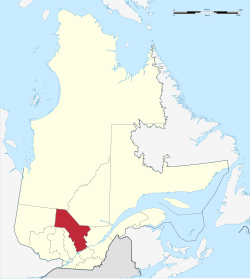Mauricie | |
|---|---|
 | |
| Coordinates: 47°00′N 73°00′W / 47.000°N 73.000°W | |
| Country | |
| Province | |
| Regional County Municipalities (RCM) and Equivalent Territories (ET) | 3 RCM, 3 ET |
| Government | |
| • Table des élus de la Mauricie (Regional conference of elected officers) | Gérard Bruneau (President) |
| Area | |
| • Land | 35,860.05 km2 (13,845.64 sq mi) |
| Population | |
| • Total | 266,112 |
| • Density | 7.4/km2 (19/sq mi) |
| • Change 2011-2016 | |
| Time zone | UTC-5 (EST) |
| • Summer (DST) | UTC-4 (EDT) |
| Postal code | |
| Area code | 819, 873 |
| Website | www |
Mauricie (French pronunciation: [mɔʁisi]) is a traditional and current administrative region of Quebec. La Mauricie National Park is contained within the region, making tourism in Mauricie popular. The region has a land area of 35,860.05 km2 (13,845.64 sq mi) and a population of 266,112 residents as of the 2016 Census.[1] Its largest cities are Trois-Rivières and Shawinigan.
The word Mauricie was coined by local priest and historian Albert Tessier and is based on the Saint-Maurice river which runs through the region on a North-South axis.
Mauricie administrative region was created on August 20, 1997 from the split of Mauricie–Bois-Francs administrative region into Mauricie and Centre-du-Québec.[2] However, the concept of Mauricie as a traditional region long predates this.
- ^ a b c "Census Profile, 2016 Census Mauricie [Economic region], Quebec". Statistics Canada. 8 February 2017. Retrieved November 22, 2019.
- ^ "Modifications aux municipalités du Québec" (PDF). Bureau de la statistique du Québec. August 1997. ISSN 0843-8250. Retrieved 2012-05-20.[permanent dead link]